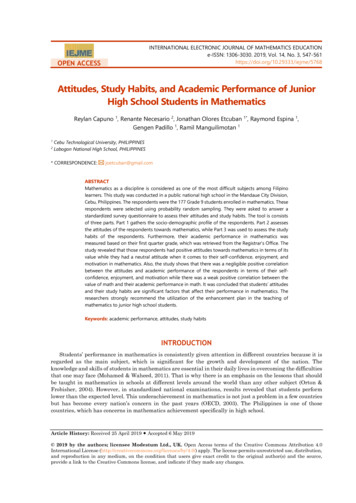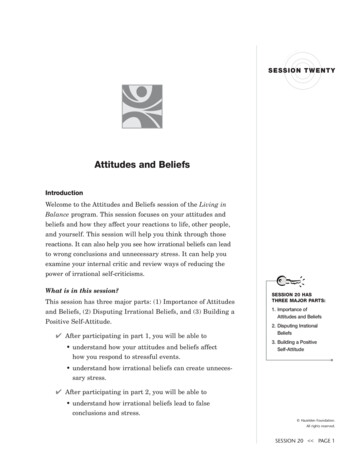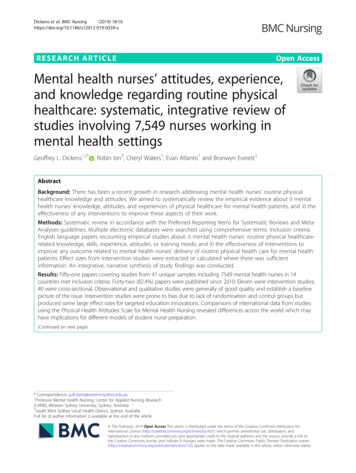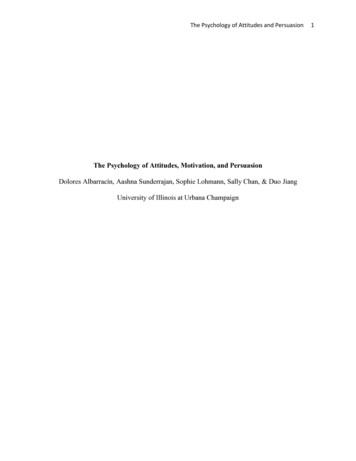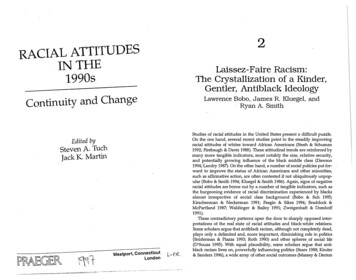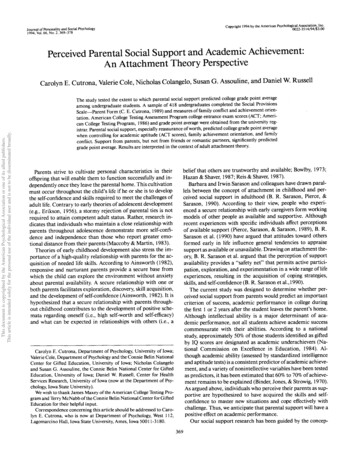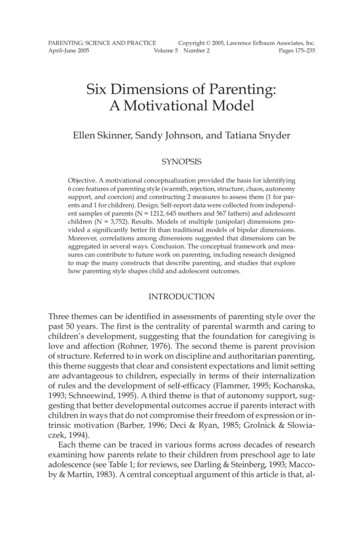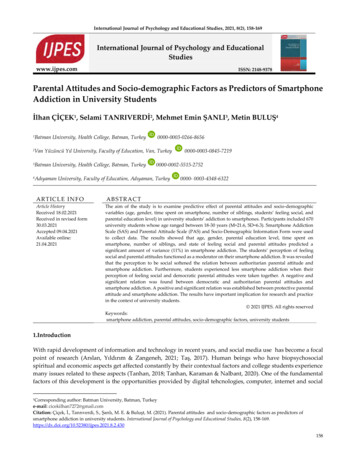
Transcription
International Journal of Psychology and Educational Studies, 2021, 8(2), 158-169International Journal of Psychology and EducationalStudieswww.ijpes.comISSN: 2148-9378Parental Attitudes and Socio-demographic Factors as Predictors of SmartphoneAddiction in University Studentsİlhan ÇİÇEK1, Selami TANRIVERDİ2, Mehmet Emin ŞANLI3, Metin BULUŞ4Batman University, Health College, Batman, Turkey10000-0003-0266-8656Van Yüzüncü Yıl University, Faculty of Education, Van, Turkey2Batman University, Health College, Batman, Turkey30000-0002-5515-2752Adıyaman University, Faculty of Education, Adıyaman, Turkey40000-0003-0845-72190000- 0003-4348-6322A R TIC LE I N F OA BS T RA C TArticle HistoryReceived 18.02.2021Received in revised form30.03.2021Accepted 09.04.2021Available online:21.04.2021The aim of the study is to examine predictive effect of parental attitudes and socio-demographicvariables (age, gender, time spent on smartphone, number of siblings, students’ feeling social, andparental education level) in university students’ addiction to smartphones. Participants included 670university students whose age ranged between 18-30 years (M 21.6, SD 6.3). Smartphone AddictionScale (SAS) and Parental Attitude Scale (PAS) and Socio-Demographic Information Form were usedto collect data. The results showed that age, gender, parental education level, time spent onsmartphone, number of siblings, and state of feeling social and parental attitudes predicted asignificant amount of variance (11%) in smartphone addiction. The students’ perception of feelingsocial and parental attitudes functioned as a moderator on their smartphone addiction. It was revealedthat the perception to be social softened the relation between authoritarian parental attitude andsmartphone addiction. Furthermore, students experienced less smartphone addiction when theirperception of feeling social and democratic parental attitudes were taken together. A negative andsignificant relation was found between democratic and authoritarian parental attitudes andsmartphone addiction. A positive and significant relation was established between protective parentalattitude and smartphone addiction. The results have important implication for research and practicein the context of university students. 2021 IJPES. All rights reservedKeywords:smartphone addiction, parental attitudes, socio-demographic factors, university students1.IntroductionWith rapid development of information and technology in recent years, and social media use has become a focalpoint of research (Arslan, Yıldırım & Zangeneh, 2021; Taş, 2017). Human beings who have biopsychosocialspiritual and economic aspects get affected constantly by their contextual factors and college students experiencemany issues related to these aspects (Tanhan, 2018; Tanhan, Karaman & Nalbant, 2020). One of the fundamentalfactors of this development is the opportunities provided by digital tehcnologies, computer, internet and social1Correspondingauthor: Batman University, Batman, Turkeye-mail: cicekilhan7272@gmail.comCitation: Çiçek, İ., Tanrıverdi, S., Şanlı, M. E. & Buluşt, M. (2021). Parental attitudes and socio-demographic factors as predictors ofsmartphone addiction in university students. International Journal of Psychology and Educational Studies, 8(2), .430158
İlhan ÇİÇEK, Selami TANRIVERDİ, Mehmet Emin ŞANLI & Metin BULUŞnetworking sites and the quick and easy access to the above-mentioned services, and separation-individuation ofpeople from others can be effective today. Therefore, it is more possible that individuals may benefit from infinitenumber of services such as communication, health, education, game, and self-realization (Aslan & Çiçek, 2020;Çiçek & Aslan, 2019; Geçer, Yıldırım & Akgül, 2020; Taş, 2019). Individuals are aware of reaching to these servicesthrough mass communication tools in general through internet use, particularly by using their smartphones.Especially, in recent years, the rapid developments in science and immense evolution in technology have madesmartphones important devices in people’s lives (Gonçalves, Dias & Correia, 2020). However, the widespread useof internet, social media, and smartphones come forefront with the benefits they provide and with the threats theypose. One of these threats can be smartphone addiction. Although the effects of internet, social media, andsmartphone use on psychology and psychological health of individuals have been noted in earlier research(Özaslan, Yıldırım, Guney, Guzel & Iseri, 2021; Sevinç & Taş, 2020; Tanhan, 2020), the wide use of masscommunication tools such as internet in general and smartphone in particular by individuals have substantiallyincreased.The total world population is 7,81 billion according to the report published by “Digital 2020: October GlobalStatshot” in October 2020 with the title, “We Are Social and Hootsuite”, which also includes importantinformation about internet, mobile devices and social media users. For example, in the report, the number ofmobile phone users, global internet users, and world-wide social media users have reached to 5,20 billion, 4,66billion, and 4,14 billion, respectively. Furthermore, nine out of 10 internet users in the world connect to the internetthrough mobile devices. In addition, when it comes to social media use, these users evidently prefer using mobiledevices. Kepios analysis, shows that 99% of social media users in the world reach this service through mobiledevices, while only one in five users use laptop or desktop devices (We Are Social, 2020a). Moreover, “Digital2020: Global Digital Overview” of We Are Social reports the prevalence of internet, social media, and mobiledevice users in Turkey. According to the report, there are 62 million internet users in Turkey. This number makes74% of the total population. There are 54 million social media users, which make 64% of the population of Turkeyalongside 77 million of mobile device users, which make 92% of Turkey’s population (We Are Social, 2020b).Since the sub-structure facilities to make internet access available have developed and smartphones have becomewidespread and their use rates have accordingly increased, all these reasons have showed an increase in internetaccess, time spent on the internet and social media. In this context, at a point where the dependence of space andtime independence created by the mobile connection to social networks and the dependence on social media andsmartphone use are taken into account, studies are carried out on university students who are thought to havemore of this addiction (Işık & Kaptangil, 2018). Therefore, when the aims of smartphone use of the youngpopulation are examined, these aims are mostly for entertainment and game (Şata, Çelik, Ertürk & Taş, 2016).Therefore, the fact that smartphones are used online more means that there could be a problem in smartphoneuse, while the literature in the field of internet addiction has documented that long term smartphone usageaddiction is related with higher addiction level (Bonilla-Zorita, Griffths & Kuss, 2020).Parental attitudes (authoritarian, protective, and democratic), family relations, and individual’s socializing stateare assumed to have effects on internet, social media, and smartphone usage level of young adults. If an individualhas a stronger desire to spend time online, this may create problems for the individual/s (Melodia, Canale &Griffiths, 2020). For this reason, when smartphone addiction is examined, addictive mobile phone use is evaluatedas an impulse control disorder similar to alcohol that does not contain an intoxicating substance and pathologicgambling (Park & Lee, 2011; Bian & Leung, 2015). When individuals using smartphone are examined, almost allsmartphone users always carry their smartphones with them. In addition, many people on public transport readthe news and surf on the social networks via their smartphones.Furthermore, some people constantly check their smartphones even when they are socializing with their friends.As such, this coercive, inability to control their behaviour, use of smart phones may adversely affect individuals'social, personal, and family relationships (Park & Lee, 2011; Wajcman, Bittman & Brown, 2008). Such behaviorshave been more prevalent during the COVID-19 pandemic (Tanhan, 2020). Research conducted during COVID19 pandemic showed that pandemic related stressors severely affect mental health of people including students159
İlhan ÇİÇEK, Selami TANRIVERDİ, Mehmet Emin ŞANLI & Metin BULUŞ(Arslan et al., 2020; Arslan, Yıldırım & Aytaç, 2020; Çiçek, Tanhan & Tanrıverdi, 2020; Yıldırım & Solmaz, 2020).While positive psychological and behavioural factors were found to positively influence well-being and mentalhealth of individuals (Çeri & Çiçek, 2021; Yıldırım & Arslan, 2020; Yıldırım & Güler, 2021), negative factorsadversely affect psychological health during COVID-19 pandemic. Researchers explained well how contextualfactors from an ecological systems theory including historical events (e.g., epidemic, pandemic, conflicts, crisis)from micro to macro system levels and even to choronsystem level constantly affect people (Tanhan, 2020).Therefore, it is considered that this paper will contribute to the extant literature in terms of taking precautionsagainst this addiction by establishing what kinds of predictors have roles in affecting youth adherence tosmartphone addiction during the pandemic. The aim of this study is to examine to what extent parental attitudespredict university students’ smartphone addiction. This study also aims to examine the effects of sociodemographic factors including gender, siblings number, parental education level, socialization perception, andtime spent on smartphone use on smartphone addiction. It is hypothesised that parental attitudes and sociodemographic factors would have significant effects on smartphone addiction.2. Method2.1. Research ModelThis study was descriptive and relational in nature of a survey method use. Survey method is an approach thataims to describe a case of past or present as it is. They are the survey arrangements carried out on a group ofpeople as whole or part of the population to conclude about the population made up of numerous elements. Ingeneral survey method, the case, person or object involved with the investigation are described within theirconditions and as they are (Karasar, 2014).2.2. Research Sample and ProcedureParticipants included 670 university students whose ages ranged from 18 to 30 years with a mean age of 21.6(SD 6.3). Great majority of the participants (70%) were girls. Before the data collection, the necessary permissionwas obtained from the Batman University ethic comittee (Ethic code: 2020/2-13). The data were collected onlineduring the COVID-19 pandemic between 14 May-1 June 2020. At the first page of online survey, the participantswere informed about the aim of the study prior their participation in the study. They were not compensated inreturn for their involvement. Given that the minimum sample size of 100 required for an analysis (Conroy, 2015),the present sample size can be considered adequate for the analysis.2.3. Data Collection ToolsSocio—demographic Information Form: This form was created by the researchers of this study. The formincluded the questions about the students’ age, gender, time spent on smartphone, number of siblings, feelingthemselves social, and parental education level.Smartphone Addiction Scale (SAS): Smartphone Addiction Short Form Scale developed by Kwon, Kim, Cho &Yang (2013), was adapted to Turkish by Noyan, Darçın, Nurmedov & Yılmaz (2015). The scale is a 6-point Likerttype with 10 items that range between 1 (certainly disagree) and 6 (certainly agree). The high scores refer to higherlevel of smartphone addiction risk. A total score can be taken from the questionnaire by summing all items andrange between 10 and 60. Noyan et al. (2015) found Cronbach alfa value of .92 in their study. In this study,Cronbach alfa value was found as .83.Parental Attitudes Scale (PAS): Parental Attitudes Scale developed by Kuzgun & Eldeleklioğlu (2005) includes40 items split into 3 sub-scales as democratic (15 items), protective/requesting (15 items), and authoritarian (10items). The high scores taken from sub-scales show high levels of individual characteristics from the related subscale. The PAS is a Likert type scale, ranging between 1 (strongly disagree) and 5 (strongly agree). An overall scorecan be estimated by summing the items on the respective scales. In the original study, Cronbach alfa values were160
İlhan ÇİÇEK, Selami TANRIVERDİ, Mehmet Emin ŞANLI & Metin BULUŞcalculated .89 for democratic attitude sub-scale, .82 for protective/requesting sub-scale, and .79 for authoritariansub-scale. In this study, Cronbach alfa value was found as .72 for democratic attitude sub-scale, .84 forprotective/requesting sub-scale and .75 for authoritarian sub-scale.2.4. Data AnalysisFirst of all, descriptive statistics including normality tests were estimated. Normality values were examined withskewness and kurtosis whose values ranging between 2 considered as approximately normally distributed at“acceptable” level (Byrne, 2010; Curran, West & Finch, 1996; Kline, 2015). The normality values of the scales werefound to be between 1 . The data were analyzed through independent t-test, ANOVA, Pearson Product Momentscorrelation, multiple linear regression and moderation analyses.3. FindingsTable 1. Descriptive Statistics for .99Gender1.310.46120.80-1.37Father's Education2.210.5913-0.10-0.44Mother's Education1.590.61130.50-0.64Time Spent on Smart-phone1.930.81140.670.09Number of Siblings3.991.2615-0.92-0.43Perception of Being Social1.370.48120.54-1.71Democratic Parenting36.606.681252-0.490.21Protective Parenting35.299.7115730.560.38Authoritarian Parenting33.706.561049-0.400.16Smart-phone Addiction28.109.2210580.37-0.39Note. N 670. Age: 1 18 – 21 years (70%), 2 22 – 25 years (23%), 3 26 years and above (6%). Gender: 0 Female (69%) and 1 Male(31%). Father’s Education: 1 No schooling (9%), 2 Primary / middle school (60%), and 3 High school and above (30%). %). Mother’sEducation: 1 No schooling (47%), 2 Primary / middle school (46%), and 3 High school and above (6%). Time Spent on Smart-phone: 1 0-2 hours (31%), 2 3-5 hours (49%), 3 6-8 hours (15%), and 4 9 hours and above (5%). Perception of Being Social: 1 Social (63%) and2 Not social (37%).The study basically was made of university students, and the ages of whom ranged from 18 to 30 years. Themajority (69%) were females. Most of the students fathers graduated from primary/middle school (60%), and mostmothers had either no schooling (47%) or primary/secondary school diplomas (46%). Nearly half of the students(49%) spent three to four hours on smartphone in a day and percieved themselves as social (63%). Skewness andkurtosis values for the main variables of interest were within 2 acceptable range which posed no immediatethreat for further analysis.The results of independent t-test analysis revealed that male participants got higher scores than femaleparticipants in only protective sub-scale of parental attitudes ( .05). No significant difference was found insmartphone addiction in terms of gender ( .05). The students who felt themselves as social had lower scores ofsmartphone addiction, and that they perceived their parents more democratic and less protective andauthoritarian. The results of ANOVA showed that the students aged between 18-21 had significantly high scoreson authoritarian parental attitudes ( .05). Students with more siblings had significantly higher scores onsmartphone addiction and authoritarian parental attitudes sub-scale. The higher smartphone use of studentsindicated a higher smartphone use scores. On the other hand, no significant difference was found between motherfather education and smartphone addiction. A significant difference was found between parental attitudes andstudents’ perceived parental attitudes.161
İlhan ÇİÇEK, Selami TANRIVERDİ, Mehmet Emin ŞANLI & Metin BULUŞCorrelation analysis in Table 2 indicates that females had more protective (r .12, p .001), and less democratic (r -.08, p .001) and authoritarian (r -.08, p .001). Participants with older ages are less protective than they are (r -.09, p .001). Having a higher degree is associated with higher scores on all three parenting attitudes; howeverit is not related to smartphone addiction. As number of siblings increase, parents are less prone to inheritdemocratic and authoritarian parenting attitudes . Democratic and authoritarian parenting attitudes subscaleswere correlated most with perception of being social. The more parents report they perceived themselves as beingsocial, the less they inherit democratic (r -.32, p .001) and authoritarian parenting attitudes (r -.33, p .001).Protective parenting style subscale is also correlated with the perception of being social; however, those reportingthat they perceived themselves as being social inherited protective parenting characteristics more (r .24, p .001).Perception of being social is also correlated with smartphone addiction (r .20, p .001).Table 2. Correlations Among Variables of Interest1. Age10.11**2345672. Gender3. Father's-0.02 0.08* Education4. Mother's-0.05 -0.04 0.36*** Education5. Time Spent on0.00-0.04 0.000.00Smart-phone6. Number of0.06-0.06 -0.28*** -0.39*** -0.01Siblings7. Perception of-0.01 -0.01 -0.09* -0.12** 0.070.11**Being Social8. Democratic-0.07 -0.08** 0.11** 0.14*** 0.03-0.14***Parenting9. Protective-0.09* 0.12** 0.09*0.020.070.03Parenting10. Authoritarian-0.08 -0.08** 0.13** 0.14*** -0.02-0.15***Parenting11. Smart-phone0.01-0.07 0.000.030.21*** -0.04AddictionNote. *p .05; **p .01; ***p .001. Reliability estimates (Cronbach’s 𝛼) are stated inParenting and Authoritarian Parenting subscales are based on reduced forms.891011-0.32***0.720.24***-0.26*** 0.84-0.33***0.83*** -0.25*** 0.750.2***-0.01*** 0.18*** -0.09**0.83bold on diagonal. Correlations for DemocraticTable 3. .Multiple Regression ResultsModel 1: Background0000Model 2: Background Parenting attitudesStandardizedEst. ariableEst. (SE)tInterceptAgeGenderFather's EducationMother'sEducationTime Spent onSmart-phoneNumber ofSiblingsPerception ofBeing 0.160.02𝜂2𝜂2162
İlhan ÇİÇEK, Selami TANRIVERDİ, Mehmet Emin ŞANLI & Metin 10.01Adj. R2 0.08Adj. R2 0.11F(7,662) 9.34***F(10,659) 9.54***Note. *p .05; **p .01; ***p .001. SE standard error (in parenthesis). 𝜂2 eta-squared that represents proportion of variance in the dependentvariable explained by the independent variables. Dependent variable is smart-phone addiction.We analyzed the data with lme4 package (Bates et al., 2015) in R statistical computing environment (R Code Team,2020). We ran a regression model that included demographic variables and some background questions (Model1) which explained 8% of the variance in the smartphone addiction. Time spent on smart-phone use andperception of being social were significant and positive predictors of smartphone addiction (β 0.20, p .001 andβ 0.20, p .001, respectively). When parenting attitudes were added in Model 2, the new variables caused asignificant change in the model. Model 2 explains 11% of the variance in the smartphone addiction. Model 2indicated that democratic and protective parenting attitudes were positively associated with the smartphoneaddiction (β 0.24, p .001 and β 0.16, p .001, respectively), whereas authoritarian parenting style wasnegatively related (β -0.21, p .01).Table 4. Moderation AnalysesVariableInterceptAgeGenderFather's EducationMother's EducationTime Spent on Smart-phoneNumber of SiblingsPerception of Being SocialDemocratic ParentingProtective ParentingAuthoritarian ParentingModerator x DemocraticParentingModerator x ProtectiveParentingModerator x AuthoritarianParentingModerator: GenderEst. (SE)t𝛽20.32(8.84)* 2.3000.52(0.58)0.90 0.03-1.04(5.56) -0.19 -0.05-0.22(0.63) -0.35 -0.010.42(0.64)0.66 0.032.14(0.42)*** 5.06 0.19-0.43(0.30) -1.44 -0.062.86(0.77)*** 3.72 0.15-0.22(0.36) -0.61 -0.160.10(0.12)0.82 0.100.21(0.36)0.58 0.14Moderator: AgeModerator: Perception of Being Social𝜂2 Est. (SE)t𝛽𝜂2Est. (SE)t𝛽𝜂20 31.64(7.56)*** 4.180030.10(8.67)*** 3.47000-7.08(4.68)-1.51 -0.4600.57(0.57)0.99 0.0400.01 -1.73(0.75)* -2.31 -0.08 0.01-1.78(0.75)* -2.38 -0.09 0.010-0.22(0.62)-0.36 -0.010-0.40(0.63)-0.63 -0.03000.43(0.64)0.67 0.0300.60(0.64)0.94 0.0400.04 2.18(0.42)*** 5.15 0.19 0.04 2.18(0.42)*** 5.17 0.190.040-0.45(0.30)-1.51 -0.060-0.39(0.30)-1.31 -0.0500.02 2.93(0.77)*** 3.81 0.15 0.02-3.82(5.57)-0.69 -0.20 0.020.01 -0.36(0.31)-1.14 -0.26 0.010.20(0.37)0.55 0.150.010.01 -0.02(0.10)-0.19 -0.02 0.010.07(0.12)0.60 0.080.0100.09(0.31)0.28 0.060-0.56(0.36)-1.56 -0.400-0.03(0.24)-0.11 -0.0400.07(0.21)0.350.160-0.33(0.24)-1.36 .08)0.460.100-0.01(0.24)-0.05 j. R2 0.10Adj. R2 0.10Adj. R2 0.11F(13,656) 6.60***F(13,656) 6.82***F(13,656) 7.13***Note. *p .05; **p .01; ***p .001. SE standard error (in parenthesis). 𝜂2 eta-squared that represents proportion of variance in the outcomeexplained by the corresponding predictor variable. Dependent variable is smart-phone addiction.Moderation analyses revealed that gender and age did not moderate the relationship between parenting attitudesand smartphone addiction. However, although not statistically significant it should be noted that standardizedcoefficients for age moderation were not very small, which may warrant further investigation. Parenting attitudesin conjunction with perception of being social tended to result in more severe smartphone addiction for older ages(democratic parenting: 𝛽 0.16, n.s., Protective Parenting: 𝛽 0.25, n.s., authoritarian parenting: 𝛽 0.16, n.s.).Perception of being social moderated the relationship between authoritarian parenting and smart-phone addiction(𝛽 0.78, p .05), meaning that authoritarian parenting in conjunction with perception of being social results inmore severe smartphone addiction. Perception of being social also moderated the relationship between democraticparenting style and smartphone addiction (𝛽 -0.48, n.s.), suggesting that democratic parenting inconjunctionwith perception of being social results in less severe smartphone addiction.163
İlhan ÇİÇEK, Selami TANRIVERDİ, Mehmet Emin ŞANLI & Metin BULUŞ4 . Conclusion and DiscussionThis study was carried out in order to determine to what extent parental style and socio-demographic variablespredict smartphone addiction among university students. The results showed that age, gender, parental educationlevel, time spent on smartphone, number of siblings, students’ feeling of being social and perceived parentalattitudes were significant predictors of smartphone addiction. Similar to some other recent studies, the findingsof this study comply with other research (Tanhan, 2020).A negative and significant relation was found between democratic and authoritarian parental attitudes, andsmartphone addiction. On the other hand, the study revealed that there was a positive and significant relationbetween protective parental attitude and smartphone addiction. This shows that the children of parents who arein protective attitude to their children have higher smartphone addiction. Limited studies are available in theliterature in relation to smartphone addiction and parental attitudes in university students. These results areconsidered to contribute to parents’ understanding of their attitudes (Özaslan & Yıldırım, 2021) so that they canbring up their children in a democratic environment, and their children can be more social in the future, and theywill experience less telephone addiction. Also, it is possible to conclude that the parents’ authoritarian attitudetowards their children and drawing strict borders are effective in their spending less time on smartphones. Atthis point, it should be noted that whether students’ perceptions of their parents' attitudes as authoritarian willhave the same effect on smartphone addiction in the following periods should be considered as an importantproblem area (Çiçek, 2020). Since parents' attitude and behaviour patterns towards children lay the groundworkfor the emergence of unwanted behavioural problems in children in the future (Çiçek & Aslan, 2020).A positive and significant relationship was found between the time spent by students on smartphones and theirsmartphone addiction. As the time spent by the students on smartphones increased, their smartphone addictionincreased. Similar results have been reported in previous studies (Geçgel, 2020; Yaran, 2020). Tanhan (2020) in aquite new and innovative qualitative study called Online Photovoice (OPV) found that college students reportingtechnology addiction during the COVID-19 pandemic as one of the most important barriers to their mental health.In their study, Noyan et al. (2015) reported that there had been a positive relation between time spent onsmartphones and smartphone addiction in university students. The result of this stuy also showed that as the timethat university students spend on smartphones increases, the smartphone addiction occurrence risk increases aswell.Another important result of the study was that the smartphone addiction level of the students who did not regardthemselves as sociable revealed to be higher than those who regarded themselves as sociable. These resultsdemonstrate that the students find smartphones as a tool to cope with challenges. Although there are not anystudies conducted between direct social self-perception and mental phone addiction, a positive relationship wasfound between students' depression levels and situations of loneliness (Tanrıverdi, 2017). In this context, it maybe assumed that university students who do not have sufficient social relations and who experience lonelinessspend more time on their smartphones to cope with these situations and therefore, they are more vulnerable tothe risk of smartphone addiction than social people. Furthermore, the results showed that students who viewedthemselves as social reported that their parents’ attitudes were more democratic. It appears that both theperception of students as social and their parents' attitudes as democratic feed each other. In addition, the scoresof authoritarian and protective parent attitudes perceived by students who viewed themselves social were low.This suggests that students' social feelings are related to their perceived parental attitudes. No research has beenfound in this context in the available literature.According to gender variable, it was found that the scores significantly differed from protective parental attitudesub-scale. In this study, male perception of parental attitude was more protective than females. Similar findingshave been reported in earlier research (Eker & Kaya, 2018; Yıldırım & Sezer, 2018). For instance, Sezer & Oğuz(2010) obtained the similar results in thier study. On the other hand, in this study, no significant difference wasfound according to gender in democratic and authoritarian parental attitudes which is in accordance withprevious studies (Çiftçi & Gülaçtı, 2019). Eker & Kaya (2018) reported no significant difference in gender variableaccording to university students’ perception democratic parental attitudes. Contradicting results have also been164
İlhan ÇİÇEK, Selami TANRIVERDİ, Mehmet Emin ŞANLI & Metin BULUŞreported (Yıldırım & Sezer, 2018). For instance, a significant difference was found in the authoritarian parentalattitude in gender variable in the study carried out by Eker & Kaya (2018).Moreover, there was no significant difference between the gender variable and smartphone addiction scores. Thisresult is consistent with previousfindings (Chen et al., 2017; Kwon et al., 2013; Tateno et al. 2019). On the otherhand, some studies found that there are significant differences in smartphone addiction according to the gendervariable (Demirci, Akgönül, & Akpınar, 2015; Tavakolizadeh, Atarodi, Ahmadpour, & Pourgheisar, 2014). Theresults of the study conducted by Choi et al. (2015) showed the smartphone addiction of girls was significantlyhigher than that of boys.A significant difference was found between the number of siblings of the students and the authoritarian parentalattitude they perceived. On the other hand, no significant difference was found between the democratic andauthoritarian attitude and the number of siblings. Students who grew up in families with many siblings viewedtheir parents less authoritarian than children with fewer siblings. There are studies that examine the relationshipbetween the number of siblings and perceived parental attitudes among university students (Alshehri, Yildirim& Vostanis, 2020; Eker & Kaya, 2018; Yıldırım & Sezer, 2018). In the study conducted by Eker & Kaya (2018), asignificant difference was observed between the perceived democratic parental attitude of university students andthe number of siblings, while no difference was found between perceived authoritarian and protective parentalattitudes and the number of siblings. According to the results obtained from the study, it was reveale
International Journal of Psychology and Educational Studies ISSN: 2148-9378 . Parental Attitudes and Socio-demographic Factors as Predictors of Smartphone Addiction in University Students . İlhan ÇİÇEK. 1, Selami TANRIVERDİ. 2, Mehmet Emin ŞANLI. 3, Metin BULUŞ. 4 . 1. Batman University, Health College
